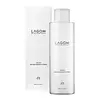What's inside
What's inside
 Key Ingredients
Key Ingredients

 Benefits
Benefits

 Concerns
Concerns

 Ingredients Side-by-side
Ingredients Side-by-side

Water
Skin ConditioningPropanediol
SolventGlycerin
HumectantDipropylene Glycol
HumectantButylene Glycol
HumectantCaprylyl Glycol
EmollientHydroxyacetophenone
AntioxidantPentylene Glycol
Skin ConditioningBetaine
HumectantPanthenol
Skin ConditioningC12-14 Pareth-12
EmulsifyingSodium Citrate
BufferingDisodium EDTA
Citric Acid
Buffering1,2-Hexanediol
Skin ConditioningSodium Hyaluronate
HumectantHydrolyzed Hyaluronic Acid
HumectantHydroxypropyltrimonium Hyaluronate
Sodium Hyaluronate Crosspolymer
HumectantSodium Acetylated Hyaluronate
HumectantGluconolactone
Skin ConditioningCentella Asiatica Extract
CleansingMadecassoside
AntioxidantMadecassic Acid
Skin ConditioningAsiaticoside
AntioxidantAsiatic Acid
Skin ConditioningCamellia Japonica Flower Extract
EmollientMelaleuca Alternifolia Leaf Extract
PerfumingSalvia Officinalis Leaf Extract
CleansingSalix Alba Bark Extract
AstringentLonicera Japonica Flower Extract
Skin ConditioningWater, Propanediol, Glycerin, Dipropylene Glycol, Butylene Glycol, Caprylyl Glycol, Hydroxyacetophenone, Pentylene Glycol, Betaine, Panthenol, C12-14 Pareth-12, Sodium Citrate, Disodium EDTA, Citric Acid, 1,2-Hexanediol, Sodium Hyaluronate, Hydrolyzed Hyaluronic Acid, Hydroxypropyltrimonium Hyaluronate, Sodium Hyaluronate Crosspolymer, Sodium Acetylated Hyaluronate, Gluconolactone, Centella Asiatica Extract, Madecassoside, Madecassic Acid, Asiaticoside, Asiatic Acid, Camellia Japonica Flower Extract, Melaleuca Alternifolia Leaf Extract, Salvia Officinalis Leaf Extract, Salix Alba Bark Extract, Lonicera Japonica Flower Extract
Water
Skin ConditioningButylene Glycol
HumectantPropanediol
SolventGlycerin
Humectant1,2-Hexanediol
Skin ConditioningXanthan Gum
EmulsifyingGlycereth-25 PCA Isostearate
EmulsifyingDiphenyl Dimethicone
EmollientTriethylhexanoin
MaskingEthylhexylglycerin
Skin ConditioningAdenosine
Skin ConditioningDisodium EDTA
Hydrogenated Lecithin
EmulsifyingHyaluronic Acid
HumectantHydrolyzed Hyaluronic Acid
HumectantPolyglyceryl-10 Oleate
Skin ConditioningSodium Hyaluronate
HumectantTricholoma Matsutake Extract
Skin ConditioningCitrus Aurantium Dulcis Oil
MaskingHydrolyzed Cicer Seed Extract
Skin ProtectingRhododendron Chrysanthum Leaf Extract
MaskingLavandula Angustifolia Oil
MaskingGeranium Maculatum Oil
MaskingCitrus Aurantium Bergamia Fruit Oil
MaskingSantalum Album Oil
MaskingHydrolyzed Vegetable Protein
Skin ConditioningMaltodextrin
AbsorbentRose Flower Oil
MaskingChamomilla Recutita Flower Oil
MaskingPalmitoyl Tripeptide-5
Skin ConditioningStyrax Benzoin Gum
MaskingCommiphora Myrrha Oil
MaskingWater, Butylene Glycol, Propanediol, Glycerin, 1,2-Hexanediol, Xanthan Gum, Glycereth-25 PCA Isostearate, Diphenyl Dimethicone, Triethylhexanoin, Ethylhexylglycerin, Adenosine, Disodium EDTA, Hydrogenated Lecithin, Hyaluronic Acid, Hydrolyzed Hyaluronic Acid, Polyglyceryl-10 Oleate, Sodium Hyaluronate, Tricholoma Matsutake Extract, Citrus Aurantium Dulcis Oil, Hydrolyzed Cicer Seed Extract, Rhododendron Chrysanthum Leaf Extract, Lavandula Angustifolia Oil, Geranium Maculatum Oil, Citrus Aurantium Bergamia Fruit Oil, Santalum Album Oil, Hydrolyzed Vegetable Protein, Maltodextrin, Rose Flower Oil, Chamomilla Recutita Flower Oil, Palmitoyl Tripeptide-5, Styrax Benzoin Gum, Commiphora Myrrha Oil
 Reviews
Reviews

Ingredients Explained
These ingredients are found in both products.
Ingredients higher up in an ingredient list are typically present in a larger amount.
1,2-Hexanediol is a synthetic liquid and another multi-functional powerhouse.
It is a:
- Humectant, drawing moisture into the skin
- Emollient, helping to soften skin
- Solvent, dispersing and stabilizing formulas
- Preservative booster, enhancing the antimicrobial activity of other preservatives
Butylene Glycol (or BG) is used within cosmetic products for a few different reasons:
Overall, Butylene Glycol is a safe and well-rounded ingredient that works well with other ingredients.
Though this ingredient works well with most skin types, some people with sensitive skin may experience a reaction such as allergic rashes, closed comedones, or itchiness.
Learn more about Butylene GlycolDisodium EDTA plays a role in making products more stable by aiding other preservatives.
It is a chelating agent, meaning it neutralizes metal ions that may be found in a product.
Disodium EDTA is a salt of edetic acid and is found to be safe in cosmetic ingredients.
Learn more about Disodium EDTAGlycerin is already naturally found in your skin. It helps moisturize and protect your skin.
A study from 2016 found glycerin to be more effective as a humectant than AHAs and hyaluronic acid.
As a humectant, it helps the skin stay hydrated by pulling moisture to your skin. The low molecular weight of glycerin allows it to pull moisture into the deeper layers of your skin.
Hydrated skin improves your skin barrier; Your skin barrier helps protect against irritants and bacteria.
Glycerin has also been found to have antimicrobial and antiviral properties. Due to these properties, glycerin is often used in wound and burn treatments.
In cosmetics, glycerin is usually derived from plants such as soybean or palm. However, it can also be sourced from animals, such as tallow or animal fat.
This ingredient is organic, colorless, odorless, and non-toxic.
Glycerin is the name for this ingredient in American English. British English uses Glycerol/Glycerine.
Learn more about GlycerinHydrolyzed Hyaluronic Acid is a form of hyaluronic acid. It is created by the hydrolysis of hyaluronic acid with a high molecular weight. Once created, Hydrolyzed Hyaluronic Acid has a low molecular weight.
Low molecular weight HA has been shown to hydrate and increase elasticity of the skin. Increasing elasticity is also associated with reduction of wrinkle depth.
One study found topical low molecular weight hyaluronic acid may be considered for the treatment of rosacea in the adult population. However, we always recommend speaking with a professional about your skin concerns.
Hyaluronic acids are a humectant. This means they draw moisture from the air. Hyaluronic acids help moisturize, soothe, and protect the skin.
Read more about other common forms of hyaluronic acid:
Learn more about Hydrolyzed Hyaluronic AcidPropanediol is an all-star ingredient. It softens, hydrates, and smooths the skin.
It’s often used to:
Propanediol is not likely to cause sensitivity and considered safe to use. It is derived from corn or petroleum with a clear color and no scent.
Learn more about PropanediolSodium Hyaluronate is hyaluronic acid's salt form. It is commonly derived from the sodium salt of hyaluronic acid.
Like hyaluronic acid, it is great at holding water and acts as a humectant. This makes it a great skin hydrating ingredient.
Sodium Hyaluronate is naturally occurring in our bodies and is mostly found in eye fluid and joints.
These are some other common types of Hyaluronic Acid:
Learn more about Sodium HyaluronateWater. It's the most common cosmetic ingredient of all. You'll usually see it at the top of ingredient lists, meaning that it makes up the largest part of the product.
So why is it so popular? Water most often acts as a solvent - this means that it helps dissolve other ingredients into the formulation.
You'll also recognize water as that liquid we all need to stay alive. If you see this, drink a glass of water. Stay hydrated!
Learn more about Water